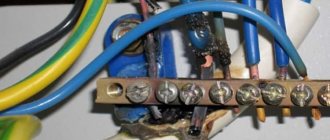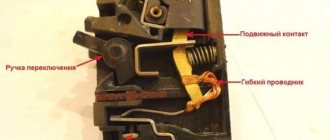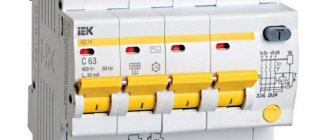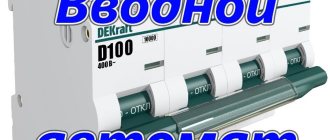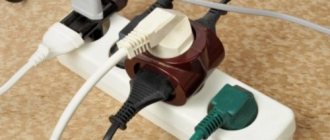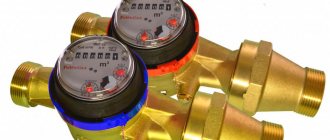Operating principle of RCD, differences from difavtomat
The requirements of the PUE indicate the need to install protective equipment. It provides protection against electric shock and breakdowns of the cable insulation coating. The RCD can be connected to 2 wires in a network with a voltage of 220 V and to 4 wires in a network of 380 V.
The disadvantage of the device is the inability to detect overload or short circuit. An automatic switch will further protect it. The difference between the devices is the response of the RCD to the current imbalance of phase and zero with a nominal value of 10-30 mA. The device does not recognize overcurrents and may even catch fire under their influence.
The difavtomat operates normally at a current of up to 16 A, and turns off the line in case of leaks. Unlike an RCD, it has a time-current characteristic, which determines the speed of shutdown.
A switch with an electromagnetic release trips when the current value exceeds 5-10 times.
Introductory machine for a private house or apartment
Internal electrical wiring includes various elements, each of which solves its own problem. One of the most important is the incoming automatic switching device, installed in front of the meter, which allows you to automatically de-energize the line in an emergency, as well as if wiring repairs are necessary.
In accordance with the requirements of the PUE, the installation of this device is mandatory, and the operation of wiring not equipped with it is not allowed. In this article we will talk about what an input circuit breaker is, how to choose this device and how input circuit breakers are calculated for a private house or apartment.
Input circuit breaker: types of devices and selection features
As mentioned above, input circuit breakers allow you to turn off the power to the electrical wiring if it needs to be repaired or upgraded. The input machine is usually not installed in the apartment; its installation is most often done on the landing. In one-story buildings they are installed outside the house, on the street. Externally, the input circuit breaker is practically indistinguishable from the protective devices mounted inside distribution boards, but the rated current for which it is designed is much higher.
Protective devices installed at the input can have from two to four poles. The number of them in the selected machine depends on the power supply mechanism, which was installed on site.
Sometimes a simple protective circuit breaker with a high current rating is placed at the input in front of the electric meter. Installation of this device does not provide reliable protection for the wiring, since when there is a loss of power, the phase line breaks, but the neutral conductor is still in contact with the electricity supply device.
What is a circuit breaker and their types - in the following video:
Which machine at nominal value should be installed in an apartment or private house can be decided by calculating the total current of the conductor and power lines. Calculations must be made based on the fact that all devices are turned on, which means that the line is under maximum load.
You should select a device whose operation in the event of a short circuit is designed to exceed the rated current by approximately 1000 A.
When selecting an input device, you should take into account the power consumed by the object, as well as the phase pattern of the power supply. In single-phase networks, a VA must be installed in front of the electric meter with two poles, for three-phase circuits - with three or four.
Voltage is supplied to the device via an overhead or underground line.
Two-pole input circuit breakers
Installation of input devices with two poles is common in typical modern apartments. In single-phase networks, devices with a current rating of 25, 32 or 50 Amperes are most often installed in front of the electric meter. A 50 A circuit breaker can withstand the greatest load, but this does not mean that it is better than others - the amount of current that the VA can withstand must correspond to the calculated one.
Structurally, the two-pole input device is a pair of combined single-terminal circuits with a common interlock, as well as a single control lever. This is due to the fact that the requirements of the PUE are prohibited from breaking the neutral circuit.
Installation of two-pole circuit breakers is carried out simultaneously on the phase and neutral cores. When the VA is triggered, the power supply to the circuit is completely interrupted.
When answering a frequently asked question: is it possible to install not a two-pole input circuit breaker, but two single-pole ones, we again turn to the Electrical Installation Rules. The requirements of this document prohibit such a procedure.
Installation of protective devices with two poles is carried out both in old residential buildings, the wiring of which, as a rule, is not provided for grounding, and in new ones. This is due to the fact that if the connection of the input machine is made by an unqualified person or an inexperienced electrician, then there is a risk of incorrect connection. If you mix up the cables, then when you turn off the protection device, it may turn out that not all the wiring in the apartment will be de-energized, but only one of its branches, which can lead to electric shock during operation.
When connecting the input two-terminal network, a phase is connected to it, which then goes to the meter, and after it to the RCD. Then it is distributed into packages. The neutral cable is connected to the second pole, from it to the electric meter, and then to the protective shutdown device for each of the wiring branches. The grounding cable, bypassing the two-terminal network, is connected to the PE bus, from which it goes to devices installed in the room. If the VA is connected in this way, then its operation will occur both on the input line and on a separate branch if the circuit breaker responsible for protecting the latter has become unusable.
Installation of an input device in three-phase networks
A three-phase network is most common in homes where cooking is done not on gas, but on electric stoves. To protect it, input circuit breakers with three or four poles are used. A three-pole device allows you to simultaneously turn off all three phases of the circuit in case of overload or short circuit. A separate phase wire is connected to each of its terminals. When asked whether the input circuit breaker is connected in a three-phase circuit before or after the meter, we answer - the VA connection is made in the same way as in a single-phase network, in front of the electric meter. To prevent electric shock to people as a result of a leak, it is recommended to include an RCD in the line.
What types of introductory pole machines are there and how they are used can be seen in the following video:
Four-pole VAs are used in three-phase electrical networks much less frequently than devices with three poles. They are usually installed in four-wire circuits. The main difference when connecting it from the three-terminal network described above is that the neutral wire is connected to the fourth pole. Otherwise, the cables are distributed in the same way as when connecting a three-pole VA. Much more often, a 4-pole device is used for a four-phase connection, since in the event of an emergency on any of the branches, it will cut off the current supply to all four.
The meter is connected in this case, as always, after the introductory machine.
When calculating an input device for a 3-phase network, you should sum up all the loads that fall on each of the current-carrying conductors.
The operating current is calculated as follows:
- We calculate how many kilowatts there are in each phase by adding up the power of the connected devices (in kW).
- We multiply the resulting amount by 1.52 (for a network with an operating voltage of 380 V) or by 4.55 (220 V).
- The result will show how many Amperes the operating current is. The nominal value should be higher, so you need to select the machine according to the closest indicator.
Features of integrated operation of protective devices
To understand how to install an RCD - after or before the machine, you need to understand the functionality of the installation. A good example would be a system consisting of a metering device, a residual current device, or a circuit breaker connected to one line.
The voltage from the transformer will pass through the RCD and the meter, supplied to the sockets. If there is no protection, the shutdown device burns out. The absence of a release in front of the meter will also lead to a line fire. The best option is a protective device on both sides.
According to the requirements of the PUE, two-pole modifications of machines are placed before the metering device. There is no need to place it in front of it - it is better to protect the line from the RCD to the consumers.
Installing an RCD before or after the machine
The device responsible for disconnecting the line does not respond to overcurrents, therefore it does not operate in the event of short circuits and overloads. A joint connection with a difavtomat will prevent these situations.
Since the circuit current exceeds the rated current, the internal components of the device are damaged and the contacts burn out. Models without built-in protective elements must be installed together with circuit breakers that will eliminate the effects of overloads and short circuits. In this case, the current of the circuit breaker should not exceed the current rating of the RCD. For example, the latter reacts to 40 A. The optimal switch for it is 36 A.
Rules for choosing a machine
The machines are selected taking into account the load parameters and characteristics of the wire. The main indicators of the circuit breaker are displayed on the front of the case in the form of markings.
Deciphering inscriptions on the machine
Depending on the voltage value and the number of poles, the following types of products are produced:
- single-pole - 220 V (for one phase wire);
- bipolar - with a similar voltage value (for 2 wires - phase and neutral);
- three-pole - 380 V (for three phase wires);
- four-pole - the same voltage (with three phase and one neutral wire).
When choosing a machine, you need to take into account the characteristics of the network and the number of wires involved. If the installed devices constantly work for no apparent reason, it makes sense to select products of higher power and install them to replace the ones in use.
We recommend: Who is exempt from contributions for major repairs of an apartment building
The device is selected based on the wire cross-section, current and power characteristics indicated in the table:
The operation of the electrical network is organized in such a way that the weak link is played by a circuit breaker that turns off when the indicators are less than critical. The devices are formed into groups, depending on the categories of consumers according to power characteristics, with the corresponding selection of device power.
One of the characteristics of the machine is time-current, the essence of which is determined by the formula:
K = I/In
wherein:
- K – multiplicity value;
- In – rated current;
- I – value of current in the network.
The following categories of multiplicity are distinguished, depending on the value of K:
- B – from 3 to 5;
- C – from 5 to 10;
- D – from 10 to 20.
As the magnification increases, the response speed of the device increases.
In addition to the multiplicity, the response speed varies depending on the ambient temperature. As it increases, a smaller current value will be required to turn off the machine.
There are 3 classes of current limitation, indicating the operating time of the device:
- third – up to 3 ms;
- second – 5 – 6 ms;
- the first is about 10 ms.
As the class increases, the cost increases and the quality of the device improves. Most household products are manufactured in the third class.
Each element is made in the form of a separate module mounted on a DIN rail. The width of one module is 17.5 mm.
Connection diagrams for RCD with switch
Protective equipment must be connected using two cables. The first will carry the load current, the second will be directed to the external circuit from the consumers. In order not to think about installing an RCD before or after the machine, you should use popular schemes.
For several groups of difavtomats - one RCD
Clause 7.1.79 of the PUE allows for the protection of several lines using an RCD. The device needs to be placed on top, then the switches on the consumer groups. In case of short circuits, the current passes through the RCD to the group circuit breaker, then to the power cable and to the consumer. If the rating of the devices is selected correctly, none of them will be damaged.
Where should the RCD be installed?
To determine where to install the residual current device, you need to remember the speed of current flow through the wires. It is equal to the speed of light - 300 thousand km/sec. In a standard C 16 machine, the turn-on time when passing currents of 5×In (80 A) will be 0.02 seconds. The distance it will cover is 6000 km.
In the event of a short circuit, the current will completely pass through the coupling device - RCD - cable - socket. In this case, the switch does not operate instantly, as a result of which the insulation melts and the socket contacts burn out.
The RCD does not fail, since a short circuit is an inertial reaction. A time of 0.02 seconds is simply not enough to melt the insulating coating and damage the parts. Even taking into account the breaking capacity, the protective devices will work properly regardless of the installation location:
- Automatic - RCD. The phase is supplied using a jumper, and the zero is supplied directly to the protective device. The wire for the sockets is connected to the device and the PE bus.
- RCD - automatic. The wire is connected to the sockets through different paths. The phase one goes to the machine, the zero goes to the protection device or the zero bus.
Thus, there is no difference where the RCD was installed - before or after the automatic device.
Where is the introductory machine installed?
The input machine can be installed before or after the counter. If installed before the electricity meter, then such a machine must be sealed.
the entry machine is sealed
For this purpose, special boxes with the possibility of sealing are produced. Or you should think about purchasing special switchboard equipment, which has a special cell for the input circuit breaker with the possibility of sealing.
Switchboard
It is necessary to take into account both which input conductor is laid to the input circuit breaker, and which conductor is laid to the loads, i.e. to lighting fixtures, sockets or any equipment.
About the repair and installation of electrical panels, read the article: “Do-it-yourself installation and repair of electrical panels”
Let's say we made a repair, replaced the aluminum wiring with copper, but such a reconstruction does not give any reason to install a 40A or 50A input circuit breaker. Because the input conductor may turn out to be too outdated and, moreover, with a cross-section of 4 square meters of aluminum. Replacing a riser with outdated wiring is not always possible. Even if we wanted to increase the rating of the input machine, sometimes this is simply unacceptable, so we will have to limit ourselves to a 25A input machine so that no trouble happens.
Machine denomination
On the body of any device the nominal value is indicated - the value of the maximum continuous current that passes through the device without harm. This parameter is safe for current switching.
To ensure protection of the RCD itself, it is necessary to install a circuit breaker with a rating similar to or 1 more than the rating of the device. If you have a machine with a rating of 16 A, the RCD should be about 25 A. This current reserve will be enough to prevent the flow of energy when the load increases.
The machine is triggered when a current appears 13% higher than the nominal value: a 16 A modification will operate at a current of 18 A. If the RCD rating is equal, the contacts may heat up. To select the rating of a system with several circuit breakers, you need to sum them up and select an RCD with a larger rating.
The nuances of installing a protective device
Connecting an RCD in an apartment or house requires compliance with several rules:
- For several groups of consumers it is necessary to install one RCD and individual circuit breakers.
- If there are several RCDs, each of them will need a zero output bus.
- The TN-C system does not need to be zeroed.
- For “wet groups” it is mandatory to install a protective device with a shutdown rating of 10 mA.
- 30 mA devices are suitable for household appliance outlets that operate with water.
- The zero terminal is located on the right side of the device and is marked with the letter N. It should not be confused with the phase (index L).
- Input can be made to the lower or upper terminals.
- The classic circuit is implemented using a top input and a bottom output.
- Each RCD requires a personal zero block to which all working neutrals are connected.
- For lines with ripple currents, type A devices are required.
You can check the health of the system by pressing the “Test” button.
A protective shutdown device is needed to protect against overloads and short circuits. Due to the lack of response to overcurrents, it is installed in combination with a difavtomat. Connection diagrams allow installation of devices in any order. The only condition is the choice of the appropriate denomination.
The need to install a switching device according to the PUE
Voltage relief devices are necessary for the safe installation of a new or replacement of an old electric meter. This is stated in paragraph 7.1.64 of the PUE: “For the safe replacement of a meter directly connected to the network, a switching device must be provided in front of each meter to relieve voltage from all phases connected to the meter.”
Thus, installation of a switching device in front of the meter is mandatory. It is also necessary to install an input machine before the meter.
What kind of apparatus should there be before and after the meter?
In this topic, I would like to discuss the installation of a direct connection meter in residential buildings. Often you have to make projects for apartments and private houses, so you need to know where to install the protective device, and where it is enough to install the switching device.
Most of all I want to focus on the device after the counter. But the fact is that before I always installed a circuit breaker after the meter, and a load switch before the meter, but you can do it differently.
Now I am working on apartment projects based on design projects. Anyone who studies my private housing design course will learn about this in even more detail. I was provided with a standard project for work, where a circuit breaker was installed in front of the meter, and a selective fire protection RCD was installed after the meter. The meter and these devices are usually installed in the floor panel. An apartment panel with group devices is installed in the apartment.
Installation of meter switching devices
Let's look at the regulatory documents:
SP 256.1325800.2016 (Electrical installations of residential and public buildings. Design and installation rules): 17.10 In front of the meter directly connected to the network, at a distance of no more than 10 m along the wiring length, for safe replacement of the meter, a switching device or fuse must be installed to relieve voltage from all phases connected to the meter.
17.11 After a meter connected directly to the power supply network, a protection device must be installed as close as possible to the meter, but no further than 3 m along the length of the electrical wiring. If several lines equipped with protection devices extend after the meter, installation of a common protection device is not required. If several lines extend after the meter, equipped with protection devices that are located outside the room where the meter is installed, then a common shutdown device must be installed after the meter.
3.1.2 protection device: A device that automatically turns off the protected electrical circuit under abnormal conditions.
3.1.62 residual current protective switching device; UDT: A mechanical switching device designed to switch on, carry and break currents under normal operating conditions, as well as open contacts when the differential current reaches a predetermined value under certain conditions.
Federal Law of the Russian Federation dated July 22, 2008 N 123-FZ “Technical Regulations on Fire Safety Requirements”:
4 Power supply lines of premises of buildings, structures and structures must have protective shutdown devices that prevent a fire from occurring in the event of a malfunction of electrical receivers. The installation rules and parameters of residual current devices must take into account the fire safety requirements established in accordance with this Federal Law.
PUE:
7.1.84. To increase the level of fire protection during short circuits to grounded parts, when the current value is insufficient to trigger the maximum current protection, at the entrance to an apartment, individual house, etc. It is recommended to install an RCD with a trip current of up to 300 mA.
The regulatory documents of the Republic of Belarus have almost the same requirements.
An automatic switch installed in front of the meter not only provides protection, but also allows you to turn off the meter if necessary. The RCD after the meter protects the apartment or house from fire and at the same time is a disconnecting device. Is an RCD a protective device? Most likely yes. Also, do not forget that the RCD will not protect the network in case of overload and short circuit currents. This function is performed by the upstream circuit breaker.
Why is it better to use just such a combination: machine-meter-RCD?
Installing a circuit breaker in front of the meter, rather than a load switch, will further protect the meter itself. When installing circuit breakers in series, selectivity requirements must also be observed. If possible, avoid installing two circuit breakers in series.
What do you install before and after the meter when designing private housing?
I recommend reading:
Electrical room lighting
Do I need an RCD for illuminated advertising?
Distance from cable to water supply in the ground
Number of cables in trench
Purpose of the introductory machine
The need to install a circuit breaker is determined by the protective system of electrical wiring from overload and the danger of short circuits. The input machine blocks the possibility of a complete blackout at home.
The input circuit breaker protects the wires from overheating, which can cause a fire hazard. The cause of cable overheating is usually long-term loads on the entire electrical network of the facility. The circuit breaker contains a thermal and electromagnetic release that prevents overheating of the wires. The switching device is necessary to de-energize the building in the event of repairs or local network failures.
Introductory machine
Replacing an old electric meter with a new one often provokes a number of questions about the need to install additional equipment: a circuit breaker or a switching device. Particularly acute is the question of whether to install an input machine before or after the meter. A complete answer to this is given by the regulatory documents of the PUE.
In Soviet times, package switches were installed in floor switchboards at the input, and today they are still installed in many places. Such outdated means of protection are dismantled, since they are no longer suitable for full operation. The replacement process raises questions about installing additional equipment.
The batch switches are replaced by an introductory automatic machine. The name gives the impression of special equipment with special functionality, but it is just a circuit breaker.
The need to install a switching device according to the PUE
Voltage relief devices are necessary for the safe installation of a new or replacement of an old electric meter. This is stated in paragraph 7.1.64 of the PUE: “For the safe replacement of a meter directly connected to the network, a switching device must be provided in front of each meter to relieve voltage from all phases connected to the meter.”
Thus, installation of a switching device in front of the meter is mandatory. It is also necessary to install an input machine before the meter.
Purpose of the introductory machine
The need to install a circuit breaker is determined by the protective system of electrical wiring from overload and the danger of short circuits. The input machine blocks the possibility of a complete blackout at home.
The input circuit breaker protects the wires from overheating, which can cause a fire hazard. The cause of cable overheating is usually long-term loads on the entire electrical network of the facility. The circuit breaker contains a thermal and electromagnetic release that prevents overheating of the wires.
The switching device is necessary to de-energize the building in the event of repairs or local network failures.
Types of input devices
There are two types of protection devices:
- 2-pole in single-phase network;
- 3-pole in a three-phase network;
- 4-pole in a three-phase network.
Most electricians prefer to install a four-pole circuit breaker in a three-phase network. Because in this case, when overheated, the neutral conductor is disconnected along with the linear conductors. Sometimes you can find a three-pole circuit breaker located at the input, during which only linear conductors are disconnected.
Advice: you should choose a device that is triggered when the norm is exceeded by 1000A: this is how much it can withstand.
Principle of operation
Usually a limit is set on the electricity consumption of a certain house or apartment. It is indicated when concluding an agreement between the energy supplier and the homeowner.
Thus, if the design documentation indicates a consumption level of 25A (amps) in a single-phase network, then this means limiting the energy to 5.5 kW.
The input circuit breaker will automatically de-energize the house if the limit is exceeded - this operating principle allows you to minimize the likelihood of a fire hazard.
Selection of circuit breaker rating
The rating of the input circuit breaker must be greater than the rating in apartment circuits. This allows you to avoid turning off all electricity if the protection works in only one of the apartments. The machine is placed on a meter with a standard size of 25 amperes.
The maximum allowable limit is 63 amps, and is usually only found in switchgear in high-rise residential complexes. How many amperes are needed is usually calculated based on the number of apartments.
Installation of an introductory machine
It doesn’t really matter whether the machine is installed after the meter or before it. The only point is that installation up to the electric meter requires mandatory sealing. Supplementing the meter with installed fuses is also necessary.
Important! The filling procedure is carried out using a special box. Otherwise, you need to purchase special panel equipment with a cell in which you can install an automatic input switch.
When positioning, it must be taken into account that the input conductor is laid exactly to the circuit breaker and is susceptible to the following loads:
- lighting;
- sockets;
- number of connected electrical appliances;
- Technical equipment.
All loads must be summed up to select a three-phase input device, which is needed to avoid overheating of the wires.
Replacing a packet switch with an automatic one
Dismantling of old equipment is usually caused by burnt contacts in old-style houses. It is impossible to repair such a breakdown, which is why it is necessary to replace the batch switch with a modern automatic analogue.
There are two methods used for repair:
- The burnt switch is dismantled, but the wires are simply twisted together - the shield continues to work, but has no protection against overheating.
- The switch is replaced with a circuit breaker.
The switching circuit of the metering device does not change: the selected input machine is connected in the same way as its predecessor.
Installation process of the introductory machine
The circuit breaker is installed on a metal profile (din rail). The batch switch is removed, after which the DIN rail is installed on the panel body using self-tapping screws. Burnt parts of the wires are removed, their ends are cleaned. If necessary, the wires inside the meter are expanded by twisting, but the wires of the apartment circuits must be changed completely. Only after this is the protection device installed.
Conclusion
The need to replace old equipment with new ones is due to home safety precautions. Only after understanding what the introductory machine is needed for, what functions it has, and whether it should be connected to the network before or after the meter, you can begin to replace it. But before replacing the old device, you need to check the quality of the wires - any faults must be removed.
Types of input devices
There are two types of protection devices:
- 2-pole in single-phase network;
- 3-pole in a three-phase network;
- 4-pole in a three-phase network.
Most electricians prefer to install a four-pole circuit breaker in a three-phase network. Because in this case, when overheated, the neutral conductor is disconnected along with the linear conductors. Sometimes you can find a three-pole circuit breaker located at the input, during which only linear conductors are disconnected.
Advice: you should choose a device that is triggered when the norm is exceeded by 1000A: this is how much it can withstand.
Principle of operation
Usually a limit is set on the electricity consumption of a certain house or apartment. It is indicated when concluding an agreement between the energy supplier and the homeowner. Thus, if the design documentation indicates a consumption level of 25A (amps) in a single-phase network, then this means limiting the energy to 5.5 kW. The input circuit breaker will automatically de-energize the house if the limit is exceeded - this operating principle allows you to minimize the likelihood of a fire hazard.
Selection of circuit breaker rating
The rating of the input circuit breaker must be greater than the rating in apartment circuits. This allows you to avoid turning off all electricity if the protection works in only one of the apartments. The machine is placed on a meter with a standard size of 25 amperes.
The maximum allowable limit is 63 amps, and is usually only found in switchgear in high-rise residential complexes. How many amperes are needed is usually calculated based on the number of apartments.
Selection of circuit breaker rating based on wire cross-section
Having determined the rating of the machine based on the power of the “suspended” load, you need to make sure that the electrical wiring can withstand the appropriate current. As a guide, you can use the table below, compiled for a copper wire and a single-phase circuit (Table 3):
As you can see, all three indicators (power, current and wire cross-section) are interconnected, so the rating of the machine can, in principle, be selected according to any of them. At the same time, it is necessary to make sure that all parameters fit together and, if necessary, make appropriate adjustments.
In any case, remember the following:
- Installing an overly powerful circuit breaker can lead to the fact that before it operates, electrical equipment that is not protected by its own fuse will fail.
- A machine with a low number of amperes can become a source of nervous stress, cutting off power to the house or individual rooms when the electric kettle, iron or vacuum cleaner is turned on.
Installation of an introductory machine
It doesn’t really matter whether the machine is installed after the meter or before it. The only point is that installation up to the electric meter requires mandatory sealing. Supplementing the meter with installed fuses is also necessary.
Important! The filling procedure is carried out using a special box. Otherwise, you need to purchase special panel equipment with a cell in which you can install an automatic input switch.
When positioning, it must be taken into account that the input conductor is laid exactly to the circuit breaker and is susceptible to the following loads:
- lighting;
- sockets;
- number of connected electrical appliances;
- Technical equipment.
All loads must be summed up to select a three-phase input device, which is needed to avoid overheating of the wires.
Is it allowed to install a switching device in front of the electric meter?
When installing a new or replacing an old electric meter, the question often arises whether it is necessary to install a circuit breaker or some other switching device in front of it. This question is fully answered by the regulatory documentation of the Electrical Installation Regulations and technical specifications for replacing electricity metering devices from grid organizations. Below you will find links to the relevant paragraphs of these documents.
Previously, batch switches were installed in the floor panels at the entrance to each apartment. They still stand in many places today. Recently, they have been diligently dismantled, since this is an outdated solution and they are in unsatisfactory condition for operation. Therefore, questions arise whether something should be put in place of them.
If we think logically, then why do we need a switching device in front of the electric meter?
First of all, it is necessary in order to be able to SAFELY install a new or replace an old electricity meter. Also, to protect the meter from short circuit currents, it is recommended to install an input circuit breaker in front of it.
Paragraph 7.1.64 of the PUE tells us about the same thing:
To safely replace a meter directly connected to the network, a switching device must be provided in front of each meter to remove voltage from all phases connected to the meter.
Now we look at the technical conditions for accepting an electric meter for registration from the network company. I will cite some points from there using the example of technical specifications for the city of Samara.
clause 1. If there is a working disconnecting device in front of the meter, it must be able to be sealed (“Rules for Electrical Installations” clause 1.5.36, clause 7.1.64). This is a 2-pole circuit breaker no higher than 40A.
clause 10. In front of the meter installed in the floor metering and distribution board, there must be a working disconnecting device with the possibility of sealing.
Now we can safely draw conclusions: It is imperative to install a switching device in front of the electric meter.
Where should the switching device be installed?
We look at the regulatory documentation of clause 1.5.36 of the PUE:
For safe installation and replacement of meters in networks with voltages up to 380 V, it must be possible to turn off the meter by switching devices or fuses of no more than 10 m Voltage relief must be provided from all phases connected to the meter.
As you can see, we are limited to a distance of 10 meters.
If the metering device is installed in a floor distribution panel, then the switching device must be installed in the same panel. Here all points of the PUE are observed.
If the meter is installed in an apartment, then it seems like you need to look at the continuation of the above-mentioned clause 7.1.64 of the PUE:
Disconnecting devices for removing voltage from settlement meters located in apartments must be located outside the apartment.
However, this point of the PUE simply physically cannot be observed everywhere. Therefore it is not observed.
Replacing a packet switch with an automatic one
Dismantling of old equipment is usually caused by burnt contacts in old-style houses. It is impossible to repair such a breakdown, which is why it is necessary to replace the batch switch with a modern automatic analogue.
There are two methods used for repair:
- The burnt switch is dismantled, but the wires are simply twisted together - the shield continues to work, but has no protection against overheating.
- The switch is replaced with a circuit breaker.
The switching circuit of the metering device does not change: the selected input machine is connected in the same way as its predecessor.



